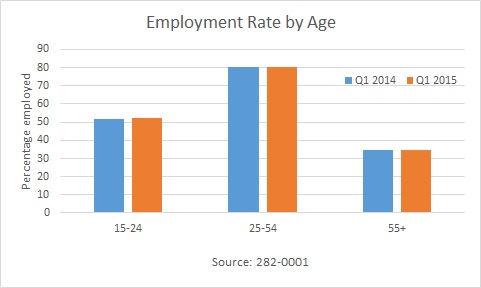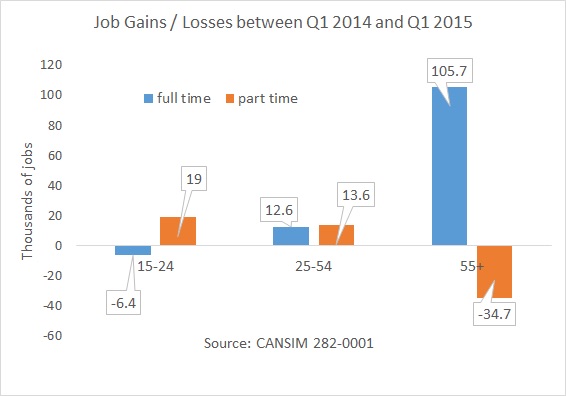The Canadian labour market added 29,000 jobs in March, beating expectations. Underneath the headline, though, the numbers aren’t as rosy.
A jump of 57,000 part-time jobs masked the loss of 28,000 full-time jobs between February and March.
Given the jumpy nature of monthly LFS data, I’ve decided to base most of my analysis on quarterly numbers. And since most of the job gains were in the 55-plus age group, I thought it would be interesting to look at the FT / PT breakdown by age.
Using seasonally unadjusted data, I compared Q1 2014 with Q1 2015. We find that part-time jobs dominate in the under-55 age group, and full-time jobs dominate in the over-55 age group. Since more boomers age into that category every day (and will be doing so for the next few years still) the meaning of that is questionable.
In fact, what we see when we look at employment rates, is that they haven’t budged for any age category. So employment growth in all age groups has only just kept pace with population growth, and not made a dent in our stagnant labour market.

Over the medium term though, we have seen an increase in the employment rate of 55-plus, and a decrease in the employment rate of 15- to 24-year-olds. Using seasonally adjusted data, there has been a steady increase in the employment rate of workers over 55, with nary a blip for the recession.
On the other hand, the employment rate for young workers 15-24 fell 5 percentage points during the recession, and remains 3 percentage point lower than in Q1 2007.

Take-away: there’s a stagnant job market for core-age workers, and an awful one for young workers.
What we don’t need is more of the same economic mismanagement, focused on cuts rather than opportunities for growth. We need to build a sustainable economy for the future.




